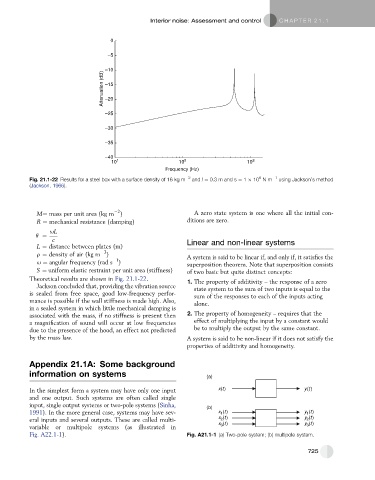Page 714 - Automotive Engineering Powertrain Chassis System and Vehicle Body
P. 714
Interior noise: Assessment and control C HAPTER 21.1
0
–5
–10
Attenuation (dB) –15
–20
–25
–30
–35
–40
10 1 10 2 10 3
Frequency (Hz)
8
Fig. 21.1-22 Results for a steel box with a surface density of 16 kg m 2 and l ¼ 0.3 m and s ¼ 1 10 Nm 1 using Jackson’s method
(Jackson, 1966).
2
M¼ mass per unit area (kg m ) A zero state system is one where all the initial con-
R ¼ mechanical resistance (damping) ditions are zero.
uL
q ¼
c Linear and non-linear systems
L ¼ distance between plates (m)
3
r ¼ density of air (kg m ) A system is said to be linear if, and only if, it satisfies the
1
u ¼ angular frequency (rad s ) superposition theorem. Note that superposition consists
S ¼ uniform elastic restraint per unit area (stiffness) of two basic but quite distinct concepts:
Theoretical results are shown in Fig. 21.1-22. 1. The property of additivity – the response of a zero
Jackson concluded that, providing the vibration source state system to the sum of two inputs is equal to the
is sealed from free space, good low-frequency perfor- sum of the responses to each of the inputs acting
mance is possible if the wall stiffness is made high. Also, alone.
in a sealed system in which little mechanical damping is
associated with the mass, if no stiffness is present then 2. The property of homogeneity – requires that the
a magnification of sound will occur at low frequencies effect of multiplying the input by a constant would
due to the presence of the hood, an effect not predicted be to multiply the output by the same constant.
by the mass law. A system is said to be non-linear if it does not satisfy the
properties of additivity and homogeneity.
Appendix 21.1A: Some background
information on systems (a)
In the simplest form a system may have only one input x(t) y(t)
and one output. Such systems are often called single
input, single output systems or two-pole systems (Sinha,
(b)
1991). In the more general case, systems may have sev- x (t) y 1 (t)
1
eral inputs and several outputs. These are called multi- x (t) y (t)
2
2
x (t) y (t)
variable or multipole systems (as illustrated in 3 3
Fig. A22.1-1). Fig. A21.1-1 (a) Two-pole system; (b) multipole system.
725

